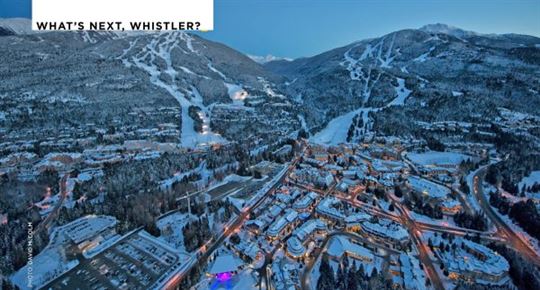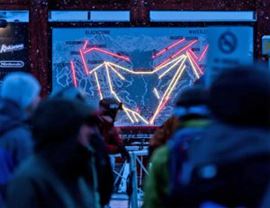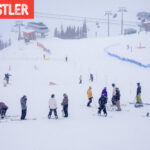It’s the question on everyone’s mind since last summer’s Vail takeover.

by STEVEN THRENDYLE in the Winter 2017 issue
Western society bestows significance to certain birthdays, like turning the “Big Five-Oh” for instance. In 2015–16, Whistler held a season-long 50th-anniversay bash that viewed the past through rose-tinted goggles.
To kick things off, Whistler’s marketing department, in conjunction with Origin Design and Switchback Productions, produced an uncommonly authentic documentary entitled Whistler: Fifty Years of Going Beyond. Using archival footage and a storytelling style that crossed Ken Burns with Stacey Peralta (Dogtown and Z-Boys), the film crackled with the kind of raw energy and ski bum nostalgia that really does make you wish you’d been nude (or at least knew someone who was) in the infamous Toad Hall poster that defined the era. As one ski bum said, “People around here are constantly looking for action and what’s next.”
The challenge became what to do for an encore, and that led to the Origin/Switchback/Whistler Blackcomb brain trust to consider Whistler’s future. Conceptualized and produced prior to Vail Resorts’s takeover of the country’s ski crown jewel last August, The Big Picture deals with four themes: climate change, skier safety in the backcountry, the “tech trap” that children fall into in our nature-starved society, and the steep decline in snowboard participation and the stagnant numbers for skiing.
Similar in scope to Sherpa Cinema’s All.I.Can., The Big Picture features talking-head experts like Whistler Blackcomb’s Mountain Planning and Environmental Resource Manager Arthur De Jong expounding upon climate change; Canadian mountain guide Keith Reid celebrating the risks and rewards of the Coast Range slackcountry; Switchback’s Mike Douglas, and his kids, getting fresh air and exercise (when they weren’t on their phones); and COO David Brownlie making a pitch to grow Whistler’s market by attracting non-skiers—even in winter—who might not be familiar with skiing and snowboarding. With its high production values and somewhat dire warnings, The Big Picture is a rather cutting-edge exercise in what’s known as “content marketing”—where corporate messages are gently bent to become more acceptable to the public. Douglas says, “We wanted to kick-start the conversation about these big issues to create awareness about the future.”
‘‘But predicting ‘what’s next’—even in the context of
a ski resort—is pretty much an impossible task.’’
But predicting “what’s next”—even in the context of a ski resort—is pretty much an impossible task. In a year in which Donald Trump won the U.S. presidency and a 3,000:1 long-shot football club won the world’s most prestigious trophy, Vail Resorts stepped in to purchase publicly traded Whistler Blackcomb for a shocking premium, enriching shareholders while at the same time encouraging trepidation from cynics who view corporate takeovers as anathema to any independently minded community.
Ski resorts are big business, and publicly traded companies like Vail Resorts hate uncertainty—like when a warm Pineapple Express punches Whistler from top to bottom in drenching rain. Concerns about the Coast Range’s low elevation and freezing levels go back to those covered walkways designed by architect Eldon Beck to protect pedestrians from precipitation. In the early days, “weatherproofing” the resort meant issuing transparent logoed plastic bags to survive riding the lower lifts in the rain. In 2016, it means Renaissance, a three-phase, $345-million plan that’s the largest capital expenditure in Whistler Blackcomb history and one to which Vail Resorts is seriously committed.

The first phase takes a “fun comes first approach,” investing $90-$100 million on creating new weather-independent, four-season attractions, including the Watershed (a state-of-the-art indoor water park), a “mountain coaster” and The Annex indoor action sports complex. Whistler will elevate the experience and raise the bar—and probably the price—even higher. Most families would probably rather spend a day at the waterslides than staring glumly into their hot chocolate, listening to wind and rain lash the windows of the day lodge. Storm season activities like climbing gyms and ice rinks already exist in Whistler, but the mountain doesn’t own any of them. Renaissance will change all that.
The community, however, sees things otherwise. In touting the threats posed by global warming and changing demographics, The Big Picture does a nifty end-around what locals consider the town’s biggest challenge, and that’s unfettered growth. Far from needing any kind of renaissance, Whistler seems to be doing extremely well on its present course. Nowadays, skiers and boarders riding the gondola from Whistler Village often share a cabin with sightseers clad in street shoes and Armani and Prada winter jackets. Indeed, the Peak 2 Peak Gondola has proven to be a success at not only moving skiers but also tourists who have no desire whatsoever to actually slide down a snowy mountainside.
For most Whistlerites, whether they are there for a good time or a long time, skiing and the mountains remain integral to the town’s cultural identity. Long before it was in vogue, Whistler’s town council and its planning department aggressively pursued an official community plan with a complicated bed cap that was supposedly breached a few years ago, but the Renaissance plan includes some high-end townhomes and what WB breathlessly calls a Dubai-style “six-star” (not that such a designation actually exists) luxury hotel. These sweet land conversions—from parking lot to condo-hotel—were the old Intrawest’s bread and butter.
‘‘My major concern with the Renaissance project is that it does not meet the smell test for the community, in particular, the previously agreed-upon bed cap (which limits the number of new units that can be built) and our official community plan.’’
That doesn’t sit right with long-time Whistlerites like Laurie Vance and her husband, Michael, who have actually been intimately involved with resort development and real estate since the late 1960s. Laurie says, “My major concern with the Renaissance project is that it does not meet the smell test for the community, in particular, the previously agreed-upon bed cap (which limits the number of new units that can be built) and our official community plan. This project serves only to provide Vail Resorts with a real estate play and more hotel beds—increasing their profit at the expense of the community. Developing the current Blackcomb Base II will take away employee parking and day-skier parking. This is simply not a sustainable model.”
Long-time Whistler resident Wendy Morrison says, “It’s full-on from December to April, it slows down a bit in May until the Mountain Bike Park opens, and then it’s full-on again from June to October.” In mid-September, she counted three different running races, the women-only Mudderella obstacle course event, two cyclocross races and a local music festival. Skiing and snowboarding might grab the Olympic limelight, but Whistler’s busiest weekend is when the annual Crankworx mountain bike event comes to town each August. (As a measure of Whistler’s popularity on summer weekends, some Vancouverites complained online that the drive from home took more than six hours on Crankworx weekend.) Even Douglas, as big a booster of Whistler as you’ll ever meet, says, “You can’t be like Christmas week, every week. We’ll self-destruct.”
Others lament that “mountain culture” has been diluted and is of but casual interest to the international visitor. But with two glossy mountain journals—along with the highly successful Pique community newsmagazine—it’s hard to make the argument that home-grown adventures aren’t being recorded or curated in some way. The historic displays found at the bursting-at-the-seams Whistler Museum ardently celebrate virtually every era of Whistler’s five decades. The community turns out in droves for the museum’s finely curated historic presentations on topics like the early exploration of Garibaldi Park in the 1920s and the Toni Sailer/Nancy Greene summer ski camp reunion last May. But Jeff Slack, the museum’s manager, notes that many Whistler visitors seem unengaged. Slack says, “Personally, I don’t think many of them come away with an appreciation of what Whistler is beyond a place to shop and party. We’re in danger of moving in an inauthentic direction.”
Indeed, the biggest epithet that’s been tossed around since Whistler started marketing to non-skiers is that the resort would become “Disneyfied.” Rodney Payne, a recent arrival to Whistler, is an internationally renowned expert on destination marketing. He says, “We’re going to land in one of two places, depending on community leadership and the balancing of resident interests with financial ones: a hollowed-out Disneyland or an authentic and thriving ski town.”
Pat Montani, a technology executive from Ontario who was perhaps Whistler’s very first telecommuter in the early days of e-mail, despairs about the opportunities for young families. “The wealthy will have homes here, while the people who support and make up the community will commute to work here,” says Montani. “It’s the people of Whistler who make it special, but as the old ones die or move on, there’s not the core who care to keep the Whistler lifestyle alive.” Some of these people are international investors like the ones who were shown mega-luxury properties last summer in a somewhat infamous YouTube video shot by a local taxi driver.
And so it goes. Though there have been lean winters in 2014 and 2015, snowmaking—even on Horstman Glacier—saved the day. Some say tourist-town residents complaining that there are too many visitors does sound a bit disingenuous. But, despite the depressing lack of housing, affordable or otherwise, ever-worsening traffic jams on Sunday afternoons and the need to plunk down $30 on a “First Tracks” breakfast in order to guarantee some kind of powder skiing on a fresh snow day, Whistler remains a successful combination of community, weekend-warrior, national and international resort.
Tourism Whistler’s CEO Barrett Fisher has heard all the complaints before—through lousy snow years and recessions and road closures. “Whistler is the cure for an aging, sedentary society looking for an authentic, back-to-nature experience,” she says. “It’s a place of celebration and energy, and an escape from concrete and glass. People who come here for the first time are still the ones who are blown away the most.”
Whistler citizens wear their passion as fervently as donning an Arc’teryx Gore-Tex jacket to do battle with a fierce Coast Range storm, which is why every new change is met with fervent opprobrium. (It’s never easy being the employer in a single-company town.) But Richard Florida, the urbanist thinker who wrote the best-selling The Rise of the Creative Class, says emphatically that “it’s far better to have problems of too much investment or too much desire to live in a certain neighbourhood or community than it is to not have that kind of enthusiasm or passion.”
Taken in that context, Whistler’s Big Picture looks pretty good. Just don’t forget your rose-tinted goggles. You’ll want to make sure you can see where you’re going before you make your next turn.
FUTURE WHISTLER
Whistler at 100? Local residents sound off on what Whistler might look like in (gulp) 2065. Of course, it will be our children who celebrate Whistler’s centenary in 49 years’ time. The rest of us will be skiing in the real Seventh Heaven, if we’re lucky.
(Answers have been edited/abbreviated.)
LAURIE VANCE, REALTOR, PREMIER PROPERTIES: “As long as we maintain the ‘community,’ future Whistler should look similar to today, with not much more build-out. We will need more affordable housing and seniors housing to support our aging population, and lifts down the right flank of Whistler Mountain to a new Cheakamus parking area for day-trippers from Vancouver.”
WENDY MORRISON, LAWYER: “There will be lifts along the Spearhead Traverse, and a high-speed train will connect Whistler to Vancouver and elsewhere. If the freezing levels rise as feared, the village will spread up the sides of the mountain, but I hope it ain’t so.”
GD MAXWELL, NEWSPAPER COLUMNIST: “I’d love to see a version of Monaco or Liechtenstein or Andorra—Canada’s only Resort Principality, a sovereign country with inextricable ties to Canada. Both Whistler and Canada would win if Whistler were a Resort Principality. I mean, how cool does a country have to be to have a Principality within its borders? We’d just rename the mayor Prince or Princess, and continue to elect our monarch.”
CATHY JEWETT, SKI PATROLLER: “Prime Minister Ella-Grace Trudeau officially opens the Golden Gondola to Fissile Peak with Trump International Ski Corp. CEO Chloe Trump.”
ANDRÉE JANYK, FORMER WHISTLER CITIZEN OF THE YEAR: “In 50 years, cars will link onto an electric highway that moves everyone along like a fast train, with stops along the way. For staff and residents, look for modular soundproof housing that’s stackable but still gives you private space at a low cost with a large common organic food garden on each lot.”
DAVID BUZZARD, NEWSPAPER PHOTOGRAPHER: “The older hotels will be upgraded and replaced in the Village, so not much will change. I could see some larger residential development in the Callaghan Valley, since that’s the only available land. Expect major residential development in Squamish and Britannia Beach, especially between Squamish and Whistler because it has huge areas suitable for development. I’d bet that Squamish will double or triple in the next 50 years, if not less.”
DOUG TRELEAVAN, REALTOR: “One surprising trend is that baby boomers are retiring to Whistler. In the future, Whistler will have much stronger community services. There’s already a site picked for a new Whistler Community Services Society that will house the food bank, ReUseIt Centre and other community services. I predict we’ll see some kind of university or post-secondary education here as well.”
GRANT LAMONT, MOUNTAIN BIKE TOUR OPERATOR & FORMER MAYOR: “It will be gone, along with the rest of the planet. I’m building a krypton-powered rocket now to make my escape.”




